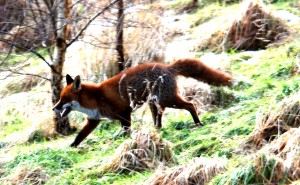 highWe often take urban wildlife for granted such as the gulls that can be seen virtually anywhere, starlings chattering away or feral doves cooing at all times of the year. However, there is another, almost secret, world out there when the various mammals come out under the cover of darkness. They wander the streets, gardens, parks and car parks searching for food and many of them are completely nocturnal in their habits. The larger mammals include the roe deer, badger and fox whilst the smaller ones range from the rabbit down to the bank voles. There are a few more specialised ones such as the otters that live along the River Ness, actually in Inverness. Seals, both common and grey seals also occur in the River Ness within the city limits and can be seen fishing for salmon much to the annoyance of local fishermen.
highWe often take urban wildlife for granted such as the gulls that can be seen virtually anywhere, starlings chattering away or feral doves cooing at all times of the year. However, there is another, almost secret, world out there when the various mammals come out under the cover of darkness. They wander the streets, gardens, parks and car parks searching for food and many of them are completely nocturnal in their habits. The larger mammals include the roe deer, badger and fox whilst the smaller ones range from the rabbit down to the bank voles. There are a few more specialised ones such as the otters that live along the River Ness, actually in Inverness. Seals, both common and grey seals also occur in the River Ness within the city limits and can be seen fishing for salmon much to the annoyance of local fishermen.
The largest of the mammals is the roe deer that seems to be still spreading within the city limits and now occupying most parks, cemeteries, and gardens. They will have their kids there and, unlike other deer, they often have twins. In recent years they have caused increasing problems with damage to trees, flowers and shrubs and there has been a great deal of discussion, so far to no conclusion, as to what to do about them. In the last few weeks Scottish Natural Heritage has announced a photographic competition for the best photographs of roe deer in the urban situation. The competition is called the “Urban Deer Photographic Competition” and is open to members of the public. The closing date for entries is March 1st and the prize is a day of photographic tuition by the SNH photographer, Lorne Gill. So why not get your camera out between now and March?
Perhaps one of the biggest surprises in this secret world is the badger but a number of people are actually feeding them each night with some people even doing the same for foxes. The badgers frequently raid garden feeders such as peanut holders for birds and their setts are more often than not under sheds. It is surprising with such a large mammal that they can go un-noticed. As with the fox the first we often see of the badger in Inverness is a dead one on the roads from a road casualty.
One of the best examples of animals adapting to the urban life is the fox, sometimes called the tod in the Highlands or Reynard in other areas. The fox in the photograph is hunting in the early morning, perhaps a sign that it had not fed during the night. Their food is entirely different than that of the fox of the wider countryside. In the urban life the fox has to scavenge, ranging from such things as litter bins or any refuse dumped by ourselves in the streets. One trait they do share with the country fox is their love of domestic birds such as chickens or ducks and they are master at raiding coups to find them. The only sight we may have of the fox at night is their eyes reflecting back in car headlights or torches. One give away at is their calls as at this time of the year, in particular, the barks and loud contact calls are made by both sexes. This includes the blood curdling scream for which the fox is famous. Foxes are social animals and even in an urban situation they live in family groups of a breeding pair, together with cubs in the spring.
Tags: highland wildlife
